Premium Only Content
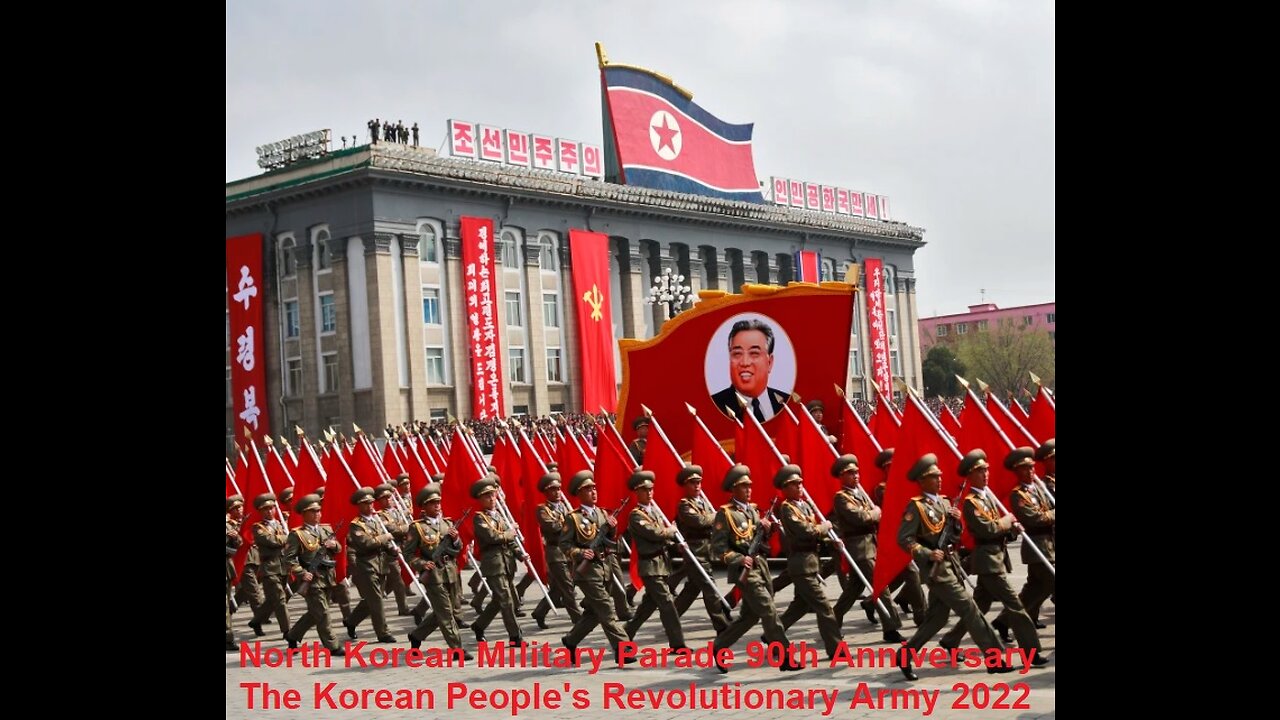
North Korean Military Parade 90th Anniversary Korean People's Revolutionary Army 2022
A military parade noteworthy in the history of the country was grandly held at Kim Il Sung Square in the capital city Pyongyang on April 25 in celebration of the 90th founding anniversary of the Korean People's Revolutionary Army.
Paratroopers displayed fascinating parachuting skills like a cluster of stars in the night sky before landing on the square, fiercely fluttering the large national flag, thus decorating the prelude to the military parade conspicuously.
The State Merited Chorus entered to play music for military parade. Then, there was a ceremony of the general military band to enter the square. The bandsmen changed formations to display the two pistols showing the origin of the revolutionary armed forces of Korea, the figures "4.25" and "90", the party emblem and the word of "Defence".
The respected Kim Jong Un, General Secretary of the Workers' Party of Korea, President of the State Affairs of the Democratic People's Republic of Korea and Supreme Commander of the Armed Forces of the DPRK, together with his wife Ri Sol Ju, arrived at the square, when there was a solemn ceremony of the guard of honour of the Korean People's Army to greet them.
Kim Jong Un received a report of salute from the commander of the guard of honour of the KPA and reviewed the guard of honour and the glorious colours of the large combined units. Amid the playing of the welcome music, Kim Jong Un came out to the rostrum of the square together with his wife Ri Sol Ju. He warmly waved his hand to acknowledge the enthusiastic cheers of the paraders and other people.
Members of the Korean Children's Union presented fragrant bouquets to Kim Jong Un and his wife Ri Sol Ju. The rostrum was taken by Pak Jong Chon, Member of the Presidium of the Political Bureau of the Central Committee of the WPK, Vice-Chairman of the Central Military Commission of the Party and Secretary of the Party Central Committee, Ri Pyong Chol, Member of the Presidium of the Political Bureau of the Central Committee of the WPK and Secretary of the Party Central Committee, leading officials of the armed forces organs, commanders of the large combined units, political commissars and commanders of the combined units.
The seats reserved for honoured guests were taken by Choe Ryong Hae, Member of the Presidium of the Political Bureau of the Central Committee of the WPK and First Vice-President of the State Affairs Commission and Chairman of the Standing Committee of the Supreme People's Assembly of the DPRK; Jo Yong Won, Member of the Presidium of the Political Bureau of the Central Committee of the WPK and Secretary for Organizational Affairs of the Party Central Committee; and Kim Tok Hun, Member of the Presidium of the Political Bureau of the Central Committee of the WPK and Vice-President of the State Affairs Commission and Premier of the Cabinet of the DPRK.
The rostrum was also taken by senior officials of the Party and the government. Invited to see the military parade were veteran cadres who have long worked in the Party, government and military organs. The reserved seats were taken by the participants in the celebrations of the 90th founding anniversary of the Korean People's Revolutionary Army. The national flag of the Democratic People's Republic of Korea was solemnly hoisted.
A 21-gun salute was fired amid the solemn playing of the song "The Glorious Motherland". Kim Jong Un made a congratulatory speech. Then, there was an inspection of preparations for the military parade. Vice-Marshal of the KPA Ri Yong Gil, Minister of National Defence of the DPRK, made a report to Marshal of the KPA Pak Jong Chon, Vice-Chairman of the Central Military Commission of the WPK, that the parade units have lined up for the inspection. Pak Jong Chon inspected the parade units.
North Korea Parades New Prototype Long-Range Missiles amid Nuclear Tensions Experts said Saturday's massive parade included prototype missiles that were longer than earlier versions and appeared to have new launch capabilities. North Korea paraded its military might Saturday in a massive public display that experts said showed new capabilities for its long-range intercontinental ballistic missiles (ICBMs).
Kim Jong Un did not speak during the huge event, which celebrates the birthday of North Korea's founding ruler Kim Il Sung, but another top official, Choe Ryong Hae, warned that the North would stand up to any threat posed by the United States. Choe said President Donald Trump was guilty of "creating a war situation" on the Korean Peninsula by dispatching U.S. forces to the region. "We will respond to an all-out war with an all-out war and a nuclear war with our style of a nuclear attack," Choe added.
The parade, the annual highlight of North Korea's most important holiday, came amid growing international worries that North Korea may be preparing for its sixth nuclear test or a major missile launch, such as its first flight test of an ICBM capable of reaching U.S. shores.
Experts said the parade included prototype missiles that were longer than previous versions and appeared to have improved launch capabilities. Kim Dong-yub, a North Korea expert at Seoul's Institute for Far Eastern Studies, said the canisters and trucks suggested that the North was developing technology to "cold launch" ICBMs, ejecting them from the canisters before they ignite. This would allow North Korea to prevent its limited number of ICBM-capable launcher trucks from being damaged during launches and also make the missiles harder to detect after they're fired, he said. Cold launches would also allow the missiles to be fired from silos.
He said it's likely that North Korea is also developing solid-fuel ICBMs and that some of the rockets inside the canisters seen on Saturday might have been prototypes. Other military hardware at the parade included tanks, multiple rocket launchers and artillery, as well as a solid-fuel missile designed to be fired from submarines. "North Korea made sure that the world saw that they are working on ICBMs and what we saw at the military parade was a prototype ICBM that will become the real deal after the necessary tests in the future," Cheong Seong-Chang, a senior fellow at The Sejong Institute in South Korea, told NBC News.
"The prototype we saw [Saturday] is longer in the length from the ones NK has previously shown the world," he added. It was not immediately clear how ready the missiles were. NBC security analyst Jeremy Bash said the parade included “a couple of familiar weapons and some paint jobs on old weapons.”
Melissa Hanham, a senior research associate at the U.S.-based Middlebury Institute of International Studies at Monterey, California, said the appearance of ICBMs enclosed in canister launchers suggested Pyongyang was working towards a "new concept" of ICBM.
"However, North Korea has a habit of showing off new concepts in parades before they ever test or launch them," she said. "It is still early days for these missile designs."
The Puk-kuk-song submarine-launched ballistic missiles (SLBM) were also on parade. It was the first time North Korea had shown the missiles, which have a range of more than 600 miles.
Displaying more than one of the missiles indicates North Korea is progressing with its plan to base a missile on a submarine, which are hard to detect, said Joshua Pollack, editor of the Washington-based Nonproliferation Review.
"It suggests a commitment to this program," said Pollack. "Multiple SLBMs seems like a declaration of intent to advance the program."
The parade, an elaborate display of the state's immense power, involves tens of thousands of participants, from goose-stepping soldiers to crowds of civilians who have spent weeks perfecting their ability to wave plastic flowers in unison.
North Korea v South Korea: Inside the world’s biggest military powers as World War 3 Looms North Korea’s repeated nuclear tests and missile launches have put the world on the brink of war as the international community tries to find a solution to the ongoing crisis. Royal North Korea v South Korea Inside the world’s biggest military powers as World War 3 looms North Korea’s repeated nuclear tests and missile launches have put the world on the brink of war as the international community tries to find a solution to the ongoing crisis.
Koreans prepare for North Korea nuclear threat with training drills South Korea and North Korea have been at odds for years having never signed a peace treaty at the end of the Korean War in 1953, and the Demilitarised Zone (DMZ) that separates the two countries stands as one of the most heavily militarised borders in the world.
The militaries of both countries are among the largest in the world and ongoing tensions from the 1950-53 Korean War continue to play a large role in determining the relations between North and South Korea.
South Korea has an active military force of 630,000 personnel, and a reserve force comprised of a staggering 7.5million troops – more than 15 per cent of its population.
With an additional 4,500 paramilitary members, the total number of people in the South Korea military stands at 8,134,500 - making it the largest force in the world. Just across the border, the North Korean army is among Kim Jong-un’s most prized assets and is comprised of millions of troops.
The secretive state rarely reveals details about its armed forces but there are believed to be 1.19 million North Korean troops in active service - meaning five per cent of the hermit state’s population is on active military duty.
There are a staggering 6.3 million troops in the reserve military, who are able to mobilise when necessary as well as a paramilitary of 189,000 troops - bringing the total number of military personnel in North Korea to 7.68million.
North Korea’s sangon policy means the military is given priority over the general population when it comes to food, fuel and other materials. North Koreans are also required to complete a ten-year enlistment in the army as part of a mandatory conscription policy, meaning most of the country has some form of military experience.
The North’s airforce is comprised of about 940 aircraft, mostly of old Soviet and Chinese origin. The MiG-21 and MiG-29 fighter jets are among the most common type of military aircraft in the North, but with Pyongyang is unable to keep up with the rest of the world in developing modern weaponry, the country’s air force is equipped with outdated weaponry.
Despite their antiquated arms, Pyongyang has the world’s largest artillery force with 10,000 pieces in its arsenal, the bulk of which is deployed along the border with South Korea. With no true international allies, North Korea is incredibly isolated and should war break out, the country would likely be offered very little help.
Some experts believe this is why the Kim Jong-un regime has made such huge efforts to develop its nuclear and ballistic capabilities because despite the size of the North Korean military, the outdated equipment and weaponry would leave Pyongyang at a severe disadvantage.
By contrast, South Korea is one of the most technologically advanced countries in the world and has numerous international allies to call on should war break out.
The US has an enormous military presence in the region and earlier this week President Trump revealed plans to sell a “substantially increased amount of highly sophisticated military equipment” to Japan and South Korea. In 2014, the South Korean military force included 2,500 tanks, 2,700 armoured fighting vehicles, 5,800 artillery pieces, 60 guided missile systems, and 600 helicopters - and given the rising tensions it is believed to have increased substantially in recent years.
The most common tank is the US-built M48 Patton, which was supplied to American allies during the Cold War but remains an established piece of military equipment in countries all over the world.
Seoul also has a huge number of US-built military aircraft, including the Northrop F-5 fighter jet - a supersonic light fighter aircraft that is often seen conducting exercises alongside its US allies.
North Korea Victory Day Parade - https://www.indiatimes.com/boyz-toyz/weapons/north-korea-victory-day-parade-91632.html?picid=745901
Korean War, conflict between the Democratic People’s Republic of Korea (North Korea) and the Republic of Korea (South Korea) in which at least 2.5 million persons lost their lives. The war reached international proportions in June 1950 when North Korea, supplied and advised by the Soviet Union, invaded the South. The United Nations, with the United States as the principal participant, joined the war on the side of the South Koreans, and the People’s Republic of China came to North Korea’s aid. After more than a million combat casualties had been suffered on both sides, the fighting ended in July 1953 with Korea still divided into two hostile states. Negotiations in 1954 produced no further agreement, and the front line has been accepted ever since as the de facto boundary between North and South Korea.
Revolution, division, and partisan warfare, 1945–50
The Korean War had its immediate origins in the collapse of the Japanese empire at the end of World War II in September 1945. Unlike China, Manchuria, and the former Western colonies seized by Japan in 1941–42, Korea, annexed to Japan since 1910, did not have a native government or a colonial regime waiting to return after hostilities ceased. Most claimants to power were harried exiles in China, Manchuria, Japan, the U.S.S.R., and the United States. They fell into two broad categories. The first was made up of committed Marxist revolutionaries who had fought the Japanese as part of the Chinese-dominated guerrilla armies in Manchuria and China. One of these exiles was a minor but successful guerrilla leader named Kim Il-sung, who had received some training in Russia and had been made a major in the Soviet army. The other Korean nationalist movement, no less revolutionary, drew its inspiration from the best of science, education, and industrialism in Europe, Japan, and America. These “ultranationalists” were split into rival factions, one of which centred on Syngman Rhee, educated in the United States and at one time the president of a dissident Korean Provisional Government in exile. In their hurried effort to disarm the Japanese army and repatriate the Japanese population in Korea (estimated at 700,000), the United States and the Soviet Union agreed in August 1945 to divide the country for administrative purposes at the 38th parallel (latitude 38° N). At least from the American perspective, this geographic division was a temporary expedient; however, the Soviets began a short-lived reign of terror in northern Korea that quickly politicized the division by driving thousands of refugees south. The two sides could not agree on a formula that would produce a unified Korea, and in 1947 U.S. President Harry S. Truman persuaded the United Nations (UN) to assume responsibility for the country, though the U.S. military remained nominally in control of the South until 1948. Both the South Korean national police and the constabulary doubled in size, providing a southern security force of about 80,000 by 1947. In the meantime, Kim Il-sung strengthened his control over the Communist Party as well as the northern administrative structure and military forces. In 1948 the North Korean military and police numbered about 100,000, reinforced by a group of southern Korean guerrillas based at Haeju in western Korea.
The creation of an independent South Korea became UN policy in early 1948. Southern communists opposed this, and by autumn partisan warfare had engulfed parts of every Korean province below the 38th parallel. The fighting expanded into a limited border war between the South’s newly formed Republic of Korea Army (ROKA) and the North Korean border constabulary as well as the North’s Korean People’s Army (KPA). The North launched 10 cross-border guerrilla incursions in order to draw ROKA units away from their guerrilla-suppression campaign in the South. In its larger purpose the partisan uprising failed: the Republic of Korea (ROK) was formed in August 1948, with Syngman Rhee as president. Nevertheless, almost 8,000 members of the South Korean security forces and at least 30,000 other Koreans lost their lives. Many of the victims were not security forces or armed guerrillas at all but simply people identified as “rightists” or “reds” by the belligerents. Small-scale atrocities became a way of life.
The partisan war also delayed the training of the South Korean army. In early 1950, American advisers judged that fewer than half of the ROKA’s infantry battalions were even marginally ready for war. U.S. military assistance consisted largely of surplus light weapons and supplies. Indeed, General Douglas MacArthur, commander of the United States’ Far East Command (FECOM), argued that his Eighth Army, consisting of four weak divisions in Japan, required more support than the Koreans. In early 1949 Kim Il-sung pressed his case with Soviet leader Joseph Stalin that the time had come for a conventional invasion of the South. Stalin refused, concerned about the relative unpreparedness of the North Korean armed forces and about possible U.S. involvement. In the course of the next year, the communist leadership built the KPA into a formidable offensive force modeled after a Soviet mechanized army. The Chinese released Korean veterans from the People’s Liberation Army, while the Soviets provided armaments. By 1950 the North Koreans enjoyed substantial advantages over the South in every category of equipment. After another Kim visit to Moscow in March–April 1950, Stalin approved an invasion.
In the predawn hours of June 25, the North Koreans struck across the 38th parallel behind a thunderous artillery barrage. The principal offensive, conducted by the KPA I Corps (53,000 men), drove across the Imjin River toward Seoul. The II Corps (54,000 soldiers) attacked along two widely separated axes, one through the cities of Ch’unch’ŏn and Inje to Hongch’ŏn and the other down the east coast road toward Kangnŭng. The KPA entered Seoul in the afternoon of June 28, but the North Koreans did not accomplish their goal of a quick surrender by the Rhee government and the disintegration of the South Korean army. Instead, remnants of the Seoul-area ROKA forces formed a defensive line south of the Han River, and on the east coast road ROKA units gave ground in good order. Still, if the South was to stave off collapse, it would need help—from the U.S. armed forces.
Truman’s initial response was to order MacArthur to transfer munitions to the ROKA and to use air cover to protect the evacuation of U.S. citizens. Instead of pressing for a congressional declaration of war, which he regarded as too alarmist and time-consuming when time was of the essence, Truman went to the United Nations for sanction. Under U.S. guidance, the UN called for the invasion to halt (June 25), then for the UN member states to provide military assistance to the ROK (June 27). By charter the Security Council considered and passed the resolutions, which could have been vetoed by a permanent member such as the Soviet Union. The Soviets, however, were boycotting the Council over the issue of admitting communist China to the UN. Congressional and public opinion in the United States, meanwhile, supported military intervention without significant dissent. Having demonstrated its political will, the Truman administration faced the unhappy truth that it did not have much effective military power to meet the invasion. MacArthur secured the commitment of three divisions from Japan, but U.S. ground forces only expanded the scope of defeat. For almost eight weeks, near Osan, along the Kum River, through Taejŏn, and south to Taegu, U.S. soldiers fought and died—and some fled. Weakened by inadequate weapons, limited numbers, and uncertain leadership, U.S. troops were frequently beset by streams of refugees fleeing south, which increased the threat of guerrilla infiltration. These conditions produced unfortunate attacks on Korean civilians, such as the firing on hundreds of refugees at a railroad viaduct near the hamlet of Nogun-ri, west of the Naktong River, during the last week in July. It was not until the first weeks of August that the United Nations Command, or UNC, as MacArthur’s theatre forces had been redesignated, started to slow the North Koreans. The Eighth Army, commanded by Lieutenant General Walton H. Walker, one of the best corps commanders in Europe in 1944–45, and the ROKA, led by Major General Chung Il-kwon, rallied and fought back with more success. Supplies came through the port at Pusan, where the Eighth Army’s logistics system depended on Korean and Japanese technicians and on thousands of Korean labourers. To stop the North Koreans’ tanks and supporting artillery and infantry, Walker brought in Sherman and Pershing medium tanks, rocket launchers, artillery pieces, antiaircraft guns, and, most important of all, close-air-support aircraft. The Fifth Air Force attacked forward units of the KPA with World War II-era P-51 Mustangs, new jet-powered F-80s and F-84s, and even B-26 and B-29 bombers. U.S. Marine Corps squadrons, embarked on navy light carriers, were capable of flying anywhere along the front in quick response to requests from ground forces, and on the east coast the U.S. Navy’s cruisers and destroyers became a seagoing heavy artillery for the ROK I Corps. Meanwhile, fresh U.S. Army and Marine Corps units began to arrive, supplemented by a British Commonwealth brigade. In the same period, the ROKA, which had shrunk to half its prewar strength through deaths, surrenders, a few defections, and substantial desertions, began to bring its ranks back up with reservists, student volunteers, and men impressed from cities’ streets as the South Koreans fell back. Concerned that the shift of combat power toward the UNC would continue into September, the field commander of the KPA, General Kim Chaek, ordered an advance against the Naktong River–Taegu–Yŏngdŏk line, soon to become famous as the “Pusan Perimeter.” The major effort was a double envelopment of Taegu, supplemented by drives toward Masan and P’ohang, the southwestern and northeastern coastal anchors of the perimeter. None reached significant objectives. At the Battle of Tabu-dong (August 18–26), the ROK 1st Division and the U.S. 27th Regimental Combat Team defeated the North Koreans’ main armoured thrust toward Taegu. By September 12 the KPA, its two corps reduced to 60,000 men and its tank forces destroyed, had been driven back in most places west of the Naktong and well away from Taegu and P’ohang. At that moment the entire strategic balance of the war was shifted by the sudden appearance of the X Corps at Inch’ŏn. MacArthur did not believe that he could win the war without an amphibious landing deep behind enemy lines, and he had started to think about a landing as early as July. For the core of his landing force, he and the Joint Chiefs of Staff selected the 1st Marine Division and the Eighth Army’s remaining infantry division, the 7th. As the force developed, it also included South Korean marine and infantry units and an assortment of U.S. support troops. The entire force was designated X Corps and was commanded by Major General Edward M. Almond, MacArthur’s chief of staff. For the landing site, MacArthur himself fixed on Inch’ŏn, the port outlet of Seoul on Korea’s west coast. A host of problems defied a landing there: wide tidal variance, mines, a crazy quilt of islands and shoal waters, and dangerous proximity to KPA reinforcements from Seoul. MacArthur brushed off all these concerns. After a naval gun and aerial bombardment on September 14, marines the next day assaulted a key harbour defense site, Wŏlmi Island, and then in the late afternoon took Inch’ŏn itself. The North Korean resistance was stubborn but spread thin, and the 1st Marine Division, accompanied by ROK and U.S. army units, entered Seoul on September 25. The bulk of the 7th Division advanced to Suwŏn, where it contacted the Eighth Army on the 26th. MacArthur and Syngman Rhee marched into the damaged capitol building and declared South Korea liberated. As an organized field force, the KPA disintegrated, having lost 13,000 as prisoners and 50,000 as casualties in August and September. Nevertheless, about 25,000 of its best troops took to the mountains and marched home as cohesive units; another 10,000 remained in South Korea as partisans. As the communists headed north, they took thousands of South Koreans with them as hostages and slave labourers and left additional thousands executed in their wake—most infamously at Taejŏn, where 5,000 civilians were massacred. The ROK army and national police, for their part, showed little sympathy to any southern communists they found or suspected, and U.S. aircraft attacked people and places with little restraint. As a result, the last two weeks of September saw atrocities rivaling those seen in Europe during the fratricidal Thirty Years’ War of the 17th century.
Even before the Inch’ŏn landing, MacArthur had thought ahead to a campaign into North Korea, though his plans never went beyond establishing a line across the so-called waist of Korea, from P’yŏngyang in the west to Wŏnsan in the east. On September 27 the Joint Chiefs gave him final authority to conduct operations north of the 38th parallel; however, he was instructed to limit operations in the event of Russian or Chinese intervention. For the UNC the war aim was expanded. As announced by the UN General Assembly on October 7, it was to include the occupation of all of North Korea and the elimination of the KPA as a threat to the political reconstruction of Korea as one nation. To that end, ROKA units crossed the parallel on October 1, and U.S. Army units crossed on October 7. The ROK I Corps marched rapidly up the east coast highway, winning the race for Wŏnsan; P’yŏngyang fell to the U.S. I Corps on October 19. The Kim Il-sung government, with the remnants of nine KPA divisions, fell back to the mountain town of Kanggye. Two other divisions, accompanied by Soviet advisers and air defense forces, struggled northwest toward the Yalu River and the Chinese border at Sinŭiju. The UNC assumed that the KPA had lost its will to fight. In reality, it was awaiting rescue. As UNC troops crossed the 38th parallel, Chinese Communist Party Chairman Mao Zedong received a plea for direct military aid from Kim Il-sung. The chairman was willing to intervene, but he needed assurances of Soviet air power. Stalin promised to extend China’s air defenses (manned by Soviets) to a corridor above the Yalu, thus protecting air bases in Manchuria and hydroelectric plants on the river, and he also promised new Soviet weapons and armaments factories. After much debate, Mao ordered the Renmin Zhiyuanjun, or Chinese People’s Volunteers Force (CPVF), to cross into Korea. It was commanded by General Peng Dehuai, a veteran of 20 years of war against the Chinese Nationalists and the Japanese. The Chinese First Offensive (October 25–November 6, 1950) had the limited objective of testing U.S.-ROK fighting qualities and slowing their advance. In the battle of Onjŏng-Unsan along the Ch’ŏngch’ŏn River, the Chinese ruined seven Korean and U.S. regiments—including the only Korean regiment to reach the Yalu, cut off in the vastness of the cold northern hills near Ch’osan. The Chinese suffered 10,000 casualties, but they were convinced that they had found a formula for fighting UNC forces: attack at night, cut off routes of supply and withdrawal, ambush counterattacking forces, and exploit all forms of concealment and cover. Stunned by the suddenness of the Chinese onslaught and almost 8,000 casualties (6,000 of them Koreans), the Eighth Army fell back to the south bank of the Ch’ŏngch’ŏn and tightened its overextended lines. With a harsh winter beginning and supplies in shortage, the pause was wise. Another matter of concern to the UNC was the appearance of MiG-15 jet fighters above North Korea. Flown by Soviet pilots masquerading as Chinese and Koreans, the MiGs, in one week’s action (November 1–7), stopped most of the daytime raids on North Korea. The U.S. Air Force immediately dispatched a crack wing of F-86 Sabre jet interceptors to Japan, and thus a two-and-a-half year battle for air superiority was joined. Over the course of the war, the F-86s succeeded in allowing the Far East Air Forces (FEAF) to conduct offensive air operations anywhere in North Korea, and they also protected the Eighth Army from communist air attack. However, they were never able to provide perfect protection for B-29s flying daylight raids into “MiG Alley,” a corridor in northwestern Korea where MiGs based near An-tung, Manchuria (now Dandong, China), fiercely defended bridges and dams on the Yalu River. The FEAF also turned its fury on all standing structures that might shield the Chinese from the cold; cities and towns all over North Korea went up in flames. But the air assault did not halt the buildup for the Chinese Second Offensive. This time Peng’s instructions to his army commanders stressed the necessity to lure the Americans and “puppet troops” out of their defensive positions between the Ch’ŏngch’ŏn and P’yŏngyang, giving the impression of weakness and confusion, while Peng would surround their forward elements with his much-enlarged force of 420,000 Chinese and North Korean regulars. MacArthur, in what may have been his only real military mistake of the war, ordered the Eighth Army and X Corps northward into the trap on November 24, and from November 25 to December 14 the Chinese battered them back to South Korea. Falling upon the U.S. IX Corps and the ROK II Corps from the east, Peng’s Thirteenth Army Group opened up a gap to the west and almost cut off the I Corps north of the Ch’ŏngch’ŏn. The I Corps managed to fight its way through Chinese ambushes back to P’yŏngyang. In the eastern sector the Chinese Ninth Army Group sent two armies against the 1st Marine Division near the Changjin Reservoir (known to the Americans by its Japanese name, Chosin). Under the worst possible weather conditions, the marines turned and fought their way south, destroying seven Chinese divisions before reaching sanctuary at the port of Hŭngnam on December 11. At the height of the crisis, MacArthur conferred with Walker and Almond, and they agreed that their forces would try to establish enclaves in North Korea, thus preserving the option of holding the P’yŏngyang-Wŏnsan line. In reality, Walker had finally reached the limits of his disgust with MacArthur’s meddling and posturing, and he started his men south. By December 6 the Eighth Army had destroyed everything it could not carry and had taken the road for Seoul. Walker’s initiative may have saved his army, but it also meant that much of the rest of the war would be fought as a UNC effort to recapture ground surrendered with little effort in December 1950. Walker himself died in a traffic accident just north of Seoul on December 23 and was succeeded by Lieutenant General Matthew B. Ridgway.
Heartened by the ease with which the CPVF had driven the UNC out of North Korea, Mao Zedong expanded his war aims to demand that the Chinese army unify all of Korea and drive the Americans and puppets off the peninsula. His enthusiasm increased when the Chinese Third Offensive (December 31, 1950–January 5, 1951) retook Seoul. The Chinese attacks centred on ROKA divisions, which were showing signs of defeatism and ineptness. Ridgway, therefore, had to rely in the short term upon his U.S. divisions, many of which had now gained units from other UN participants. In addition to two British Commonwealth brigades, there were units from Turkey, France, Belgium, The Netherlands, Greece, Colombia, Thailand, Ethiopia, and the Philippines. Pulling his multinational force together, Ridgway pushed back to the Han River valley in January 1951.
The Chinese, now reinforced by a reborn North Korean army, launched their Fourth Offensive on February 11, 1951. Again the initial attacks struck ill-prepared South Korean divisions, and again the UNC gave ground. Again the Eighth Army fought back methodically, crossing the 38th parallel after two months. At that point Peng began the Fifth Offensive (First Phase) with 11 Chinese armies and two North Korean corps. The attacks came at an awkward moment for the Eighth Army. On April 11 Truman, having reached the opinion that MacArthur’s independence amounted to insubordination, had relieved the general of all his commands and recalled him to the United States. The change elevated Ridgway to commander in chief, FECOM and UNC, and brought Lieutenant General James A. Van Fleet to command the Eighth Army. Like Ridgway, Van Fleet had earned wide respect as a division and corps commander against the Germans in 1944–45. Before Van Fleet could re-form the ROK Army and redeploy his own divisions, the Chinese struck. At a low point in Korean military history, the battered ROKA II Corps gave way, and U.S. divisions peeled back to protect their flanks and rear until Van Fleet could commit five more U.S. and Korean divisions and a British brigade to halt the Chinese armies on April 28. Mao refused to accept Peng’s report that the CPVF could no longer hold the initiative, and he ordered the Second Phase of the offensive, which began on May 16 and lasted another bloody week. Once again allied air power and heavy artillery stiffened the resistance, and once again the UNC crossed the 38th parallel in pursuit of a battered (but not beaten) Chinese expeditionary force.
A military parade noteworthy in the history of the country was grandly held at Kim Il Sung Square in the capital city Pyongyang on April 25 in celebration of the 90th founding anniversary of the Korean People's Revolutionary Army.
Paratroopers displayed fascinating parachuting skills like a cluster of stars in the night sky before landing on the square, fiercely fluttering the large national flag, thus decorating the prelude to the military parade conspicuously.
The State Merited Chorus entered to play music for military parade. Then, there was a ceremony of the general military band to enter the square. The bandsmen changed formations to display the two pistols showing the origin of the revolutionary armed forces of Korea, the figures "4.25" and "90", the party emblem and the word of "Defence".
The respected Kim Jong Un, General Secretary of the Workers' Party of Korea, President of the State Affairs of the Democratic People's Republic of Korea and Supreme Commander of the Armed Forces of the DPRK, together with his wife Ri Sol Ju, arrived at the square, when there was a solemn ceremony of the guard of honour of the Korean People's Army to greet them.
Kim Jong Un received a report of salute from the commander of the guard of honour of the KPA and reviewed the guard of honour and the glorious colours of the large combined units. Amid the playing of the welcome music, Kim Jong Un came out to the rostrum of the square together with his wife Ri Sol Ju. He warmly waved his hand to acknowledge the enthusiastic cheers of the paraders and other people.
Members of the Korean Children's Union presented fragrant bouquets to Kim Jong Un and his wife Ri Sol Ju. The rostrum was taken by Pak Jong Chon, Member of the Presidium of the Political Bureau of the Central Committee of the WPK, Vice-Chairman of the Central Military Commission of the Party and Secretary of the Party Central Committee, Ri Pyong Chol, Member of the Presidium of the Political Bureau of the Central Committee of the WPK and Secretary of the Party Central Committee, leading officials of the armed forces organs, commanders of the large combined units, political commissars and commanders of the combined units.
The seats reserved for honoured guests were taken by Choe Ryong Hae, Member of the Presidium of the Political Bureau of the Central Committee of the WPK and First Vice-President of the State Affairs Commission and Chairman of the Standing Committee of the Supreme People's Assembly of the DPRK; Jo Yong Won, Member of the Presidium of the Political Bureau of the Central Committee of the WPK and Secretary for Organizational Affairs of the Party Central Committee; and Kim Tok Hun, Member of the Presidium of the Political Bureau of the Central Committee of the WPK and Vice-President of the State Affairs Commission and Premier of the Cabinet of the DPRK.
The rostrum was also taken by senior officials of the Party and the government. Invited to see the military parade were veteran cadres who have long worked in the Party, government and military organs. The reserved seats were taken by the participants in the celebrations of the 90th founding anniversary of the Korean People's Revolutionary Army. The national flag of the Democratic People's Republic of Korea was solemnly hoisted.
A 21-gun salute was fired amid the solemn playing of the song "The Glorious Motherland". Kim Jong Un made a congratulatory speech. Then, there was an inspection of preparations for the military parade. Vice-Marshal of the KPA Ri Yong Gil, Minister of National Defence of the DPRK, made a report to Marshal of the KPA Pak Jong Chon, Vice-Chairman of the Central Military Commission of the WPK, that the parade units have lined up for the inspection. Pak Jong Chon inspected the parade units.
North Korea Parades New Prototype Long-Range Missiles amid Nuclear Tensions Experts said Saturday's massive parade included prototype missiles that were longer than earlier versions and appeared to have new launch capabilities. North Korea paraded its military might Saturday in a massive public display that experts said showed new capabilities for its long-range intercontinental ballistic missiles (ICBMs).
Kim Jong Un did not speak during the huge event, which celebrates the birthday of North Korea's founding ruler Kim Il Sung, but another top official, Choe Ryong Hae, warned that the North would stand up to any threat posed by the United States. Choe said President Donald Trump was guilty of "creating a war situation" on the Korean Peninsula by dispatching U.S. forces to the region. "We will respond to an all-out war with an all-out war and a nuclear war with our style of a nuclear attack," Choe added.
The parade, the annual highlight of North Korea's most important holiday, came amid growing international worries that North Korea may be preparing for its sixth nuclear test or a major missile launch, such as its first flight test of an ICBM capable of reaching U.S. shores.
Experts said the parade included prototype missiles that were longer than previous versions and appeared to have improved launch capabilities. Kim Dong-yub, a North Korea expert at Seoul's Institute for Far Eastern Studies, said the canisters and trucks suggested that the North was developing technology to "cold launch" ICBMs, ejecting them from the canisters before they ignite. This would allow North Korea to prevent its limited number of ICBM-capable launcher trucks from being damaged during launches and also make the missiles harder to detect after they're fired, he said. Cold launches would also allow the missiles to be fired from silos.
He said it's likely that North Korea is also developing solid-fuel ICBMs and that some of the rockets inside the canisters seen on Saturday might have been prototypes. Other military hardware at the parade included tanks, multiple rocket launchers and artillery, as well as a solid-fuel missile designed to be fired from submarines. "North Korea made sure that the world saw that they are working on ICBMs and what we saw at the military parade was a prototype ICBM that will become the real deal after the necessary tests in the future," Cheong Seong-Chang, a senior fellow at The Sejong Institute in South Korea, told NBC News.
"The prototype we saw [Saturday] is longer in the length from the ones NK has previously shown the world," he added. It was not immediately clear how ready the missiles were. NBC security analyst Jeremy Bash said the parade included “a couple of familiar weapons and some paint jobs on old weapons.”
Melissa Hanham, a senior research associate at the U.S.-based Middlebury Institute of International Studies at Monterey, California, said the appearance of ICBMs enclosed in canister launchers suggested Pyongyang was working towards a "new concept" of ICBM.
"However, North Korea has a habit of showing off new concepts in parades before they ever test or launch them," she said. "It is still early days for these missile designs."
The Puk-kuk-song submarine-launched ballistic missiles (SLBM) were also on parade. It was the first time North Korea had shown the missiles, which have a range of more than 600 miles.
Displaying more than one of the missiles indicates North Korea is progressing with its plan to base a missile on a submarine, which are hard to detect, said Joshua Pollack, editor of the Washington-based Nonproliferation Review.
"It suggests a commitment to this program," said Pollack. "Multiple SLBMs seems like a declaration of intent to advance the program."
The parade, an elaborate display of the state's immense power, involves tens of thousands of participants, from goose-stepping soldiers to crowds of civilians who have spent weeks perfecting their ability to wave plastic flowers in unison.
North Korea v South Korea: Inside the world’s biggest military powers as World War 3 Looms North Korea’s repeated nuclear tests and missile launches have put the world on the brink of war as the international community tries to find a solution to the ongoing crisis. Royal North Korea v South Korea Inside the world’s biggest military powers as World War 3 looms North Korea’s repeated nuclear tests and missile launches have put the world on the brink of war as the international community tries to find a solution to the ongoing crisis.
Koreans prepare for North Korea nuclear threat with training drills South Korea and North Korea have been at odds for years having never signed a peace treaty at the end of the Korean War in 1953, and the Demilitarised Zone (DMZ) that separates the two countries stands as one of the most heavily militarised borders in the world.
The militaries of both countries are among the largest in the world and ongoing tensions from the 1950-53 Korean War continue to play a large role in determining the relations between North and South Korea.
South Korea has an active military force of 630,000 personnel, and a reserve force comprised of a staggering 7.5million troops – more than 15 per cent of its population.
With an additional 4,500 paramilitary members, the total number of people in the South Korea military stands at 8,134,500 - making it the largest force in the world. Just across the border, the North Korean army is among Kim Jong-un’s most prized assets and is comprised of millions of troops.
The secretive state rarely reveals details about its armed forces but there are believed to be 1.19 million North Korean troops in active service - meaning five per cent of the hermit state’s population is on active military duty.
There are a staggering 6.3 million troops in the reserve military, who are able to mobilise when necessary as well as a paramilitary of 189,000 troops - bringing the total number of military personnel in North Korea to 7.68million.
North Korea’s sangon policy means the military is given priority over the general population when it comes to food, fuel and other materials. North Koreans are also required to complete a ten-year enlistment in the army as part of a mandatory conscription policy, meaning most of the country has some form of military experience.
The North’s airforce is comprised of about 940 aircraft, mostly of old Soviet and Chinese origin. The MiG-21 and MiG-29 fighter jets are among the most common type of military aircraft in the North, but with Pyongyang is unable to keep up with the rest of the world in developing modern weaponry, the country’s air force is equipped with outdated weaponry.
Despite their antiquated arms, Pyongyang has the world’s largest artillery force with 10,000 pieces in its arsenal, the bulk of which is deployed along the border with South Korea. With no true international allies, North Korea is incredibly isolated and should war break out, the country would likely be offered very little help.
Some experts believe this is why the Kim Jong-un regime has made such huge efforts to develop its nuclear and ballistic capabilities because despite the size of the North Korean military, the outdated equipment and weaponry would leave Pyongyang at a severe disadvantage.
By contrast, South Korea is one of the most technologically advanced countries in the world and has numerous international allies to call on should war break out.
The US has an enormous military presence in the region and earlier this week President Trump revealed plans to sell a “substantially increased amount of highly sophisticated military equipment” to Japan and South Korea. In 2014, the South Korean military force included 2,500 tanks, 2,700 armoured fighting vehicles, 5,800 artillery pieces, 60 guided missile systems, and 600 helicopters - and given the rising tensions it is believed to have increased substantially in recent years.
The most common tank is the US-built M48 Patton, which was supplied to American allies during the Cold War but remains an established piece of military equipment in countries all over the world.
Seoul also has a huge number of US-built military aircraft, including the Northrop F-5 fighter jet - a supersonic light fighter aircraft that is often seen conducting exercises alongside its US allies.
North Korea Victory Day Parade - https://www.indiatimes.com/boyz-toyz/weapons/north-korea-victory-day-parade-91632.html?picid=745901
Korean War, conflict between the Democratic People’s Republic of Korea (North Korea) and the Republic of Korea (South Korea) in which at least 2.5 million persons lost their lives. The war reached international proportions in June 1950 when North Korea, supplied and advised by the Soviet Union, invaded the South. The United Nations, with the United States as the principal participant, joined the war on the side of the South Koreans, and the People’s Republic of China came to North Korea’s aid. After more than a million combat casualties had been suffered on both sides, the fighting ended in July 1953 with Korea still divided into two hostile states. Negotiations in 1954 produced no further agreement, and the front line has been accepted ever since as the de facto boundary between North and South Korea.
Revolution, division, and partisan warfare, 1945–50
The Korean War had its immediate origins in the collapse of the Japanese empire at the end of World War II in September 1945. Unlike China, Manchuria, and the former Western colonies seized by Japan in 1941–42, Korea, annexed to Japan since 1910, did not have a native government or a colonial regime waiting to return after hostilities ceased. Most claimants to power were harried exiles in China, Manchuria, Japan, the U.S.S.R., and the United States. They fell into two broad categories. The first was made up of committed Marxist revolutionaries who had fought the Japanese as part of the Chinese-dominated guerrilla armies in Manchuria and China. One of these exiles was a minor but successful guerrilla leader named Kim Il-sung, who had received some training in Russia and had been made a major in the Soviet army. The other Korean nationalist movement, no less revolutionary, drew its inspiration from the best of science, education, and industrialism in Europe, Japan, and America. These “ultranationalists” were split into rival factions, one of which centred on Syngman Rhee, educated in the United States and at one time the president of a dissident Korean Provisional Government in exile. In their hurried effort to disarm the Japanese army and repatriate the Japanese population in Korea (estimated at 700,000), the United States and the Soviet Union agreed in August 1945 to divide the country for administrative purposes at the 38th parallel (latitude 38° N). At least from the American perspective, this geographic division was a temporary expedient; however, the Soviets began a short-lived reign of terror in northern Korea that quickly politicized the division by driving thousands of refugees south. The two sides could not agree on a formula that would produce a unified Korea, and in 1947 U.S. President Harry S. Truman persuaded the United Nations (UN) to assume responsibility for the country, though the U.S. military remained nominally in control of the South until 1948. Both the South Korean national police and the constabulary doubled in size, providing a southern security force of about 80,000 by 1947. In the meantime, Kim Il-sung strengthened his control over the Communist Party as well as the northern administrative structure and military forces. In 1948 the North Korean military and police numbered about 100,000, reinforced by a group of southern Korean guerrillas based at Haeju in western Korea.
The creation of an independent South Korea became UN policy in early 1948. Southern communists opposed this, and by autumn partisan warfare had engulfed parts of every Korean province below the 38th parallel. The fighting expanded into a limited border war between the South’s newly formed Republic of Korea Army (ROKA) and the North Korean border constabulary as well as the North’s Korean People’s Army (KPA). The North launched 10 cross-border guerrilla incursions in order to draw ROKA units away from their guerrilla-suppression campaign in the South. In its larger purpose the partisan uprising failed: the Republic of Korea (ROK) was formed in August 1948, with Syngman Rhee as president. Nevertheless, almost 8,000 members of the South Korean security forces and at least 30,000 other Koreans lost their lives. Many of the victims were not security forces or armed guerrillas at all but simply people identified as “rightists” or “reds” by the belligerents. Small-scale atrocities became a way of life.
The partisan war also delayed the training of the South Korean army. In early 1950, American advisers judged that fewer than half of the ROKA’s infantry battalions were even marginally ready for war. U.S. military assistance consisted largely of surplus light weapons and supplies. Indeed, General Douglas MacArthur, commander of the United States’ Far East Command (FECOM), argued that his Eighth Army, consisting of four weak divisions in Japan, required more support than the Koreans. In early 1949 Kim Il-sung pressed his case with Soviet leader Joseph Stalin that the time had come for a conventional invasion of the South. Stalin refused, concerned about the relative unpreparedness of the North Korean armed forces and about possible U.S. involvement. In the course of the next year, the communist leadership built the KPA into a formidable offensive force modeled after a Soviet mechanized army. The Chinese released Korean veterans from the People’s Liberation Army, while the Soviets provided armaments. By 1950 the North Koreans enjoyed substantial advantages over the South in every category of equipment. After another Kim visit to Moscow in March–April 1950, Stalin approved an invasion.
In the predawn hours of June 25, the North Koreans struck across the 38th parallel behind a thunderous artillery barrage. The principal offensive, conducted by the KPA I Corps (53,000 men), drove across the Imjin River toward Seoul. The II Corps (54,000 soldiers) attacked along two widely separated axes, one through the cities of Ch’unch’ŏn and Inje to Hongch’ŏn and the other down the east coast road toward Kangnŭng. The KPA entered Seoul in the afternoon of June 28, but the North Koreans did not accomplish their goal of a quick surrender by the Rhee government and the disintegration of the South Korean army. Instead, remnants of the Seoul-area ROKA forces formed a defensive line south of the Han River, and on the east coast road ROKA units gave ground in good order. Still, if the South was to stave off collapse, it would need help—from the U.S. armed forces.
Truman’s initial response was to order MacArthur to transfer munitions to the ROKA and to use air cover to protect the evacuation of U.S. citizens. Instead of pressing for a congressional declaration of war, which he regarded as too alarmist and time-consuming when time was of the essence, Truman went to the United Nations for sanction. Under U.S. guidance, the UN called for the invasion to halt (June 25), then for the UN member states to provide military assistance to the ROK (June 27). By charter the Security Council considered and passed the resolutions, which could have been vetoed by a permanent member such as the Soviet Union. The Soviets, however, were boycotting the Council over the issue of admitting communist China to the UN. Congressional and public opinion in the United States, meanwhile, supported military intervention without significant dissent. Having demonstrated its political will, the Truman administration faced the unhappy truth that it did not have much effective military power to meet the invasion. MacArthur secured the commitment of three divisions from Japan, but U.S. ground forces only expanded the scope of defeat. For almost eight weeks, near Osan, along the Kum River, through Taejŏn, and south to Taegu, U.S. soldiers fought and died—and some fled. Weakened by inadequate weapons, limited numbers, and uncertain leadership, U.S. troops were frequently beset by streams of refugees fleeing south, which increased the threat of guerrilla infiltration. These conditions produced unfortunate attacks on Korean civilians, such as the firing on hundreds of refugees at a railroad viaduct near the hamlet of Nogun-ri, west of the Naktong River, during the last week in July. It was not until the first weeks of August that the United Nations Command, or UNC, as MacArthur’s theatre forces had been redesignated, started to slow the North Koreans. The Eighth Army, commanded by Lieutenant General Walton H. Walker, one of the best corps commanders in Europe in 1944–45, and the ROKA, led by Major General Chung Il-kwon, rallied and fought back with more success. Supplies came through the port at Pusan, where the Eighth Army’s logistics system depended on Korean and Japanese technicians and on thousands of Korean labourers. To stop the North Koreans’ tanks and supporting artillery and infantry, Walker brought in Sherman and Pershing medium tanks, rocket launchers, artillery pieces, antiaircraft guns, and, most important of all, close-air-support aircraft. The Fifth Air Force attacked forward units of the KPA with World War II-era P-51 Mustangs, new jet-powered F-80s and F-84s, and even B-26 and B-29 bombers. U.S. Marine Corps squadrons, embarked on navy light carriers, were capable of flying anywhere along the front in quick response to requests from ground forces, and on the east coast the U.S. Navy’s cruisers and destroyers became a seagoing heavy artillery for the ROK I Corps. Meanwhile, fresh U.S. Army and Marine Corps units began to arrive, supplemented by a British Commonwealth brigade. In the same period, the ROKA, which had shrunk to half its prewar strength through deaths, surrenders, a few defections, and substantial desertions, began to bring its ranks back up with reservists, student volunteers, and men impressed from cities’ streets as the South Koreans fell back. Concerned that the shift of combat power toward the UNC would continue into September, the field commander of the KPA, General Kim Chaek, ordered an advance against the Naktong River–Taegu–Yŏngdŏk line, soon to become famous as the “Pusan Perimeter.” The major effort was a double envelopment of Taegu, supplemented by drives toward Masan and P’ohang, the southwestern and northeastern coastal anchors of the perimeter. None reached significant objectives. At the Battle of Tabu-dong (August 18–26), the ROK 1st Division and the U.S. 27th Regimental Combat Team defeated the North Koreans’ main armoured thrust toward Taegu. By September 12 the KPA, its two corps reduced to 60,000 men and its tank forces destroyed, had been driven back in most places west of the Naktong and well away from Taegu and P’ohang. At that moment the entire strategic balance of the war was shifted by the sudden appearance of the X Corps at Inch’ŏn. MacArthur did not believe that he could win the war without an amphibious landing deep behind enemy lines, and he had started to think about a landing as early as July. For the core of his landing force, he and the Joint Chiefs of Staff selected the 1st Marine Division and the Eighth Army’s remaining infantry division, the 7th. As the force developed, it also included South Korean marine and infantry units and an assortment of U.S. support troops. The entire force was designated X Corps and was commanded by Major General Edward M. Almond, MacArthur’s chief of staff. For the landing site, MacArthur himself fixed on Inch’ŏn, the port outlet of Seoul on Korea’s west coast. A host of problems defied a landing there: wide tidal variance, mines, a crazy quilt of islands and shoal waters, and dangerous proximity to KPA reinforcements from Seoul. MacArthur brushed off all these concerns. After a naval gun and aerial bombardment on September 14, marines the next day assaulted a key harbour defense site, Wŏlmi Island, and then in the late afternoon took Inch’ŏn itself. The North Korean resistance was stubborn but spread thin, and the 1st Marine Division, accompanied by ROK and U.S. army units, entered Seoul on September 25. The bulk of the 7th Division advanced to Suwŏn, where it contacted the Eighth Army on the 26th. MacArthur and Syngman Rhee marched into the damaged capitol building and declared South Korea liberated. As an organized field force, the KPA disintegrated, having lost 13,000 as prisoners and 50,000 as casualties in August and September. Nevertheless, about 25,000 of its best troops took to the mountains and marched home as cohesive units; another 10,000 remained in South Korea as partisans. As the communists headed north, they took thousands of South Koreans with them as hostages and slave labourers and left additional thousands executed in their wake—most infamously at Taejŏn, where 5,000 civilians were massacred. The ROK army and national police, for their part, showed little sympathy to any southern communists they found or suspected, and U.S. aircraft attacked people and places with little restraint. As a result, the last two weeks of September saw atrocities rivaling those seen in Europe during the fratricidal Thirty Years’ War of the 17th century.
Even before the Inch’ŏn landing, MacArthur had thought ahead to a campaign into North Korea, though his plans never went beyond establishing a line across the so-called waist of Korea, from P’yŏngyang in the west to Wŏnsan in the east. On September 27 the Joint Chiefs gave him final authority to conduct operations north of the 38th parallel; however, he was instructed to limit operations in the event of Russian or Chinese intervention. For the UNC the war aim was expanded. As announced by the UN General Assembly on October 7, it was to include the occupation of all of North Korea and the elimination of the KPA as a threat to the political reconstruction of Korea as one nation. To that end, ROKA units crossed the parallel on October 1, and U.S. Army units crossed on October 7. The ROK I Corps marched rapidly up the east coast highway, winning the race for Wŏnsan; P’yŏngyang fell to the U.S. I Corps on October 19. The Kim Il-sung government, with the remnants of nine KPA divisions, fell back to the mountain town of Kanggye. Two other divisions, accompanied by Soviet advisers and air defense forces, struggled northwest toward the Yalu River and the Chinese border at Sinŭiju. The UNC assumed that the KPA had lost its will to fight. In reality, it was awaiting rescue. As UNC troops crossed the 38th parallel, Chinese Communist Party Chairman Mao Zedong received a plea for direct military aid from Kim Il-sung. The chairman was willing to intervene, but he needed assurances of Soviet air power. Stalin promised to extend China’s air defenses (manned by Soviets) to a corridor above the Yalu, thus protecting air bases in Manchuria and hydroelectric plants on the river, and he also promised new Soviet weapons and armaments factories. After much debate, Mao ordered the Renmin Zhiyuanjun, or Chinese People’s Volunteers Force (CPVF), to cross into Korea. It was commanded by General Peng Dehuai, a veteran of 20 years of war against the Chinese Nationalists and the Japanese. The Chinese First Offensive (October 25–November 6, 1950) had the limited objective of testing U.S.-ROK fighting qualities and slowing their advance. In the battle of Onjŏng-Unsan along the Ch’ŏngch’ŏn River, the Chinese ruined seven Korean and U.S. regiments—including the only Korean regiment to reach the Yalu, cut off in the vastness of the cold northern hills near Ch’osan. The Chinese suffered 10,000 casualties, but they were convinced that they had found a formula for fighting UNC forces: attack at night, cut off routes of supply and withdrawal, ambush counterattacking forces, and exploit all forms of concealment and cover. Stunned by the suddenness of the Chinese onslaught and almost 8,000 casualties (6,000 of them Koreans), the Eighth Army fell back to the south bank of the Ch’ŏngch’ŏn and tightened its overextended lines. With a harsh winter beginning and supplies in shortage, the pause was wise. Another matter of concern to the UNC was the appearance of MiG-15 jet fighters above North Korea. Flown by Soviet pilots masquerading as Chinese and Koreans, the MiGs, in one week’s action (November 1–7), stopped most of the daytime raids on North Korea. The U.S. Air Force immediately dispatched a crack wing of F-86 Sabre jet interceptors to Japan, and thus a two-and-a-half year battle for air superiority was joined. Over the course of the war, the F-86s succeeded in allowing the Far East Air Forces (FEAF) to conduct offensive air operations anywhere in North Korea, and they also protected the Eighth Army from communist air attack. However, they were never able to provide perfect protection for B-29s flying daylight raids into “MiG Alley,” a corridor in northwestern Korea where MiGs based near An-tung, Manchuria (now Dandong, China), fiercely defended bridges and dams on the Yalu River. The FEAF also turned its fury on all standing structures that might shield the Chinese from the cold; cities and towns all over North Korea went up in flames. But the air assault did not halt the buildup for the Chinese Second Offensive. This time Peng’s instructions to his army commanders stressed the necessity to lure the Americans and “puppet troops” out of their defensive positions between the Ch’ŏngch’ŏn and P’yŏngyang, giving the impression of weakness and confusion, while Peng would surround their forward elements with his much-enlarged force of 420,000 Chinese and North Korean regulars. MacArthur, in what may have been his only real military mistake of the war, ordered the Eighth Army and X Corps northward into the trap on November 24, and from November 25 to December 14 the Chinese battered them back to South Korea. Falling upon the U.S. IX Corps and the ROK II Corps from the east, Peng’s Thirteenth Army Group opened up a gap to the west and almost cut off the I Corps north of the Ch’ŏngch’ŏn. The I Corps managed to fight its way through Chinese ambushes back to P’yŏngyang. In the eastern sector the Chinese Ninth Army Group sent two armies against the 1st Marine Division near the Changjin Reservoir (known to the Americans by its Japanese name, Chosin). Under the worst possible weather conditions, the marines turned and fought their way south, destroying seven Chinese divisions before reaching sanctuary at the port of Hŭngnam on December 11. At the height of the crisis, MacArthur conferred with Walker and Almond, and they agreed that their forces would try to establish enclaves in North Korea, thus preserving the option of holding the P’yŏngyang-Wŏnsan line. In rea
-
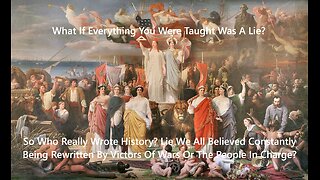 1:50:00
1:50:00
What If Everything You Were Taught Was A Lie?
14 days agoSo Who Really Wrote History? Lie We All Believed Constantly Being Rewritten By Victors Of Wars?
2.6K5 -
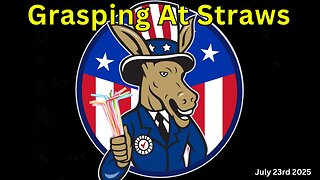 LIVE
LIVE
Wendy Bell Radio
4 hours agoGrasping At Straws
7,883 watching -
 LIVE
LIVE
Chicks On The Right
3 hours agoOzzy gone, Portnoy vs Schultz, more on Colbert show ending, and Candace's likely new guest
2,329 watching -
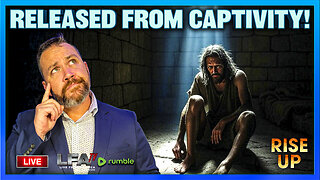 LIVE
LIVE
LFA TV
11 hours agoLFA TV ALL DAY STREAM - WEDNESDAY 7/23/25
7,729 watching -
 1:18:00
1:18:00
Game On!
16 hours ago $1.44 earnedJayden Daniels Can Do What Only 8 Other NFL QBs Have Done Before!
8.81K1 -
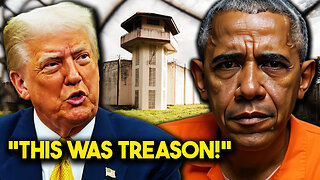 LIVE
LIVE
The Bubba Army
23 hours agoTrump accuses Obama of TREASON! - Bubba the Love Sponge® Show | 7/23/25
2,372 watching -
 28:26
28:26
Producer Michael
20 hours agoIS THIS MY MOST CRAZY PURCHASE YET?!
10.7K2 -
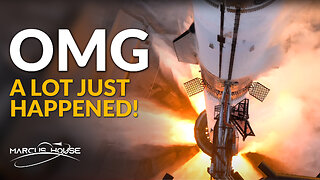 23:21
23:21
marcushouse
8 hours ago $1.10 earnedStarship Flight When!? Yea, a LOT Just Happened!
9.29K1 -
 23:48
23:48
Jasmin Laine
17 hours ago“We Reject Demographic Change”—Carney’s Comment BLOWS UP as Poilievre Drops the Hammer
11.4K20 -
 2:02:28
2:02:28
BEK TV
1 day agoTrent Loos in the Morning 7/23/2025
10.3K